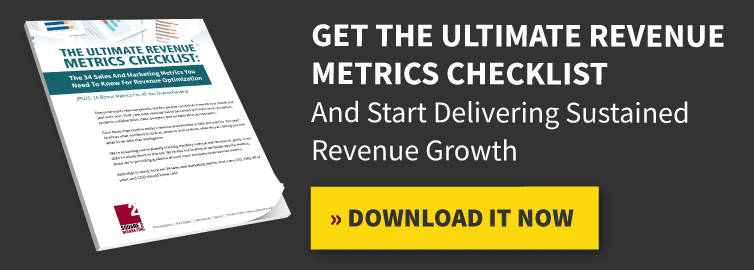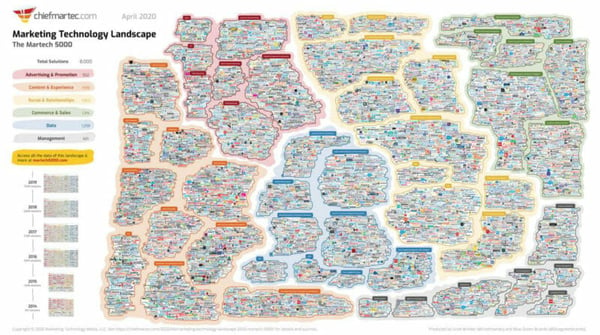
The 4 Pillars Of Revenue Generation; Find Out If You’re Missing All 4
Strategy, Tactics, Analytics And Technology Are Required If Revenue Growth Is Your Goal
 Prospects are asking these questions all the time: Why isn’t my marketing working? Why isn’t our company growing? Why aren’t we getting more leads?
Prospects are asking these questions all the time: Why isn’t my marketing working? Why isn’t our company growing? Why aren’t we getting more leads?
The answer quite simply is that you’re not doing everything you need to do to grow revenue.
It’s not your fault. You’re an expert at developing software, providing accounting services, manufacturing products or offering telecom services. You wouldn’t expect me to know everything about your business, and I don’t expect you to know exactly how to generate leads, sales opportunities and new customers.
But what I can tell you is there are four foundational elements to producing a revenue generation machine that month over month allows you to generate more revenue for your company.
I can also tell you that these four elements are extremely difficult to dial in, and almost every company we work with is missing at least one of these when we start our engagement with them.
You need each of these four to be working in concert across marketing, sales and customer service for your company to grow.
If you’re not growing, the challenge to growth likely lies in one of these four areas.
1) Strategy
Hands down, this is one of the most neglected areas in most businesses. No, not the overall business strategy — that’s usually well-defined. It’s the strategy around marketing and sales that is almost always light.
Specifically, what’s needed around strategy is a clear understanding of who (exactly) you want to do business with, down to the individual level. This is often referred to as personas. Most companies have a decent idea of who their personas are, and some have at least some parts of a persona profile completed and defined.
But we still find a lot of companies that need their personas built out in much more detail.
If you can’t quickly tell me who your best prospects are, including detailed demographic and psychographic characteristics for everyone who participates in the purchase decision for your products or services, you might need more work on this too.
In case you don’t know, demographics are usually known characteristics for the company, like SIC code, number of employees, revenue, location, etc.
Psychographics are attitudes, interests, opinions and the lifestyles of the people you want to reach with your marketing.
Once you know your personas, now you need a disruptive, compelling and emotional story to move those people to action. This is by far the most common missing piece of the puzzle from the strategy element.
Besides the story, you’ll need to know what makes your company remarkable — not differentiation, which doesn’t go far enough, but actually remarkable. Something that no other competitor can even say. To be remarkable means you’re telling prospects a story that no other company can replicate.
You’ll need to be intimate with your prospects’ buyer journeys as part of strategy, too. This means you’ve mapped out every single touch point where your business touches your prospects and your customers. The buyer journey starts when a person hears about your business and won’t end until the relationship between your company and that person ends.
You’ll need to align marketing, sales and customer service across your entire company as part of your strategy work. And last but not least, you’ll need to create the financial investment required to deliver the level of revenue growth you aspire to create.
If you think you can generate an incremental $1 million over the next 12 months and invest only $500 a month to do so, you are mistaken. There is a lack of alignment between investment and results. The goals must be aligned with the level of investment required to achieve those goals.
You should be able to see that the strategy pillar in the four foundational elements is complicated, requires thought and demands experience to set it up in a complete and effective way. If this pillar is missing, flawed or incomplete, the revenue generation machine will fail.
In the companies that come to us for help, this is also one of the most common points of failure in their efforts to drive revenue.
2) Tactics
The second pillar is tactics. This is an interesting pillar. While a lot of companies we talk to are missing the strategy pillar, almost every company we meet with has something going on in the tactics pillar.
However, that doesn’t mean they’re executing tactics correctly, productively, efficiently or in alignment with their overall strategy.
Today there are hundreds of marketing, sales and customer service-related tactics, and almost all of them need to be used at some point or another if you want month-over-month revenue generation.
Many of these tactics you’re already very familiar with. Your website, email campaigns, social media, video marketing, getting found on Google, content marketing and account-based marketing are all examples of marketing tactics that you’ve probably heard of or tried.
Some you might not be familiar with tactics like advocacy marketing, using intent data, paid social media advertising, lead nurturing or influencer marketing.
While you may be executing tactics today, it’s likely that you don’t have all of the tactics necessary to drive revenue, you haven’t prioritized the tactics correctly and you haven’t properly orchestrated every tactic in a way that produces a “one plus one equals three” outcome.
Again, it’s not for lack of trying. But the experience required to set up orchestrated tactical execution across marketing, sales and customer service requires doing it hundreds of times, over and over again, to ensure it’s done correctly, in the right sequences, with the right connections and in a way that produces the business outcomes your business desires.
If I handed you a golf club and you’ve never played golf or only played golf a few times, you might be able to hit the ball. You might even hit the ball well a few times, but it’s not likely that you’ll be driving the ball 290 yards every time you hit it.
Wouldn’t it be nice to have a professional golfer with you to either hit the ball for you or to show you exactly how to hit the ball so you groove your swing for consistency, performance and enjoyment of the game? You don’t have to answer that.
3) Analytics
Unfortunately, this is another weak spot for most businesses. When it comes to marketing, sales and customer service, measuring performance is not something most businesses have a long track record with.
The third of the four pillars for revenue growth is analytics.
Sales is easy to track. Did your reps hit their quotas? Did the company hit its goals? But after that it’s downhill. Take this little quiz and see how many questions you can answer related to the quantitative metrics associated with your company’s revenue performance:
- How many people came to your website last month?
- How many MQLs (marketing-qualified leads) were generated by your entire marketing effort?
- How many SQLs (sales-qualified leads) were generated by your entire marketing effort?
- How many email addresses are in your prospect database? How many net new do you add each week?
- What is the site-wide conversion rate on your website?
- What is your close rate on sales opportunities? (This is not proposals submitted.)
- What is the length of your sales cycle, in days, from first click to your website to signed paperwork?
- What is the average annual revenue from a new customer?
- How many customers buy everything you sell?
- How many customers are advocates for your business?
These 10 simple questions require numeric answers. You either know them or you don’t.
For your revenue generation efforts to work, these 10 basic numbers should be on the tip of your tongue daily. They should be updated weekly, and you should be working with your team to ensure they are improving week over week and certainly month over month.
These 10 numbers are basic. Today many companies are moving on to more advanced analytics, with very specific dashboards created for each stage of the buyer journey.
It’s no longer enough to know how your email marketing campaigns are working or what sources are producing the most visitors to your website.
Today it’s about the collection of tactics that are driving the performance of your orchestrated marketing tactics for the Pre-Awareness or Awareness stages of your buyer journey.
Each stage of the buyer journey should have its own dashboard that shows you how the collection of tactics are moving the needle at each stage. This is going to allow you to see the insights you’ve been missing.
Insights are what data is supposed to produce. You should be able to review the data and uncover the insights necessary for you to make adjustments (some subtle and some more significant) on a weekly, monthly and quarterly basis, so that marketing, sales and customer service execution gets better over time.
This unfortunately is missing in almost every single client that starts working with Square 2.
Getting these insights to inform action planning is one of the most difficult parts of revenue generation today.
4) Technology
That brings us to the fourth of the four foundational pillars required for revenue growth. Because strategy, tactics and analytics are so complex today, and require a massive amount of knowledge and experience to execute effectively, we use technology to make it all easier and more automated.
But marketing, sales and customer service technology introduce their own set of complications.
Today there are over 8,000 marketing, sales and customer service-related technologies. Who could possibly sift through 8,000 tools, get an understanding of them all, select and implement just the ones you need to help you grow and then become an expert in those tools to make the adjustments required to gain true ROI from your investment in those technologies?
Don’t even bother trying to read this — it’s just for illustration purposes. Again, it’s a massive undertaking for anyone.
How do you know which technology to buy? How many tools do you need? What are the business outcomes you want? How much should you spend on technology? How do you get the technology to work together? What is a tech stack?
In case you’re curious, a tech stack is the collection of software tools you’re using to achieve a specific business objective, like revenue growth. It’s rare that one single tool will do everything your company needs. It’s more likely that you’ll need a collection of software applications.
The more complicated your requirements, the more tools you’ll probably need. You won’t need anywhere close to the thousands in the image above, but finding the five or six you do need is still a massive and highly complicated effort.
Your first move is to define what you need technology to do. Technology rarely solves a business problem, and it’s almost always the combination of people, process and technology that produces the desired results.
The people and the process challenges are for another day and another article; the tech is what we’ll focus on today.
You want to know your challenges. Are they marketing, sales or customer service-related? Or do you have challenges with all three? Solid revenue growth generally means all three areas of your business are firing on all cylinders, so software that makes execution around all three is key.
Do you have performance challenges? Automation challenges? Efficiency challenges?
Revenue growth comes from getting data, uncovering the insights and then using that knowledge to adjust every single month. We typically call this optimization.
But there is normally so much to do that you need some help in the automation area, too. Posting articles to social media can be time-consuming, but if you have software that automatically does this, you can do more with the resources you have.
Efficiency is about what you get for your investment in marketing, sales and customer service. If you’re sending emails to customers and prospects, and you’re sending everyone the email on Tuesday at 10 a.m., you could be looking at a 20% open rate and a 2% click-through rate.
But if you can use a software tool that based on artificial intelligence (AI) sends emails to people based on their email behaviors, and that improves your open rate to 35% and your click-through rate to 5%, that is a worthwhile investment.
That’s a significant improvement in efficiency. Imagine you send emails once a week 52 times a year — that’s a major lift.
Now you might be looking at platform tools like HubSpot or Marketo on the marketing side, HubSpot or Salesforce on the sales side and HubSpot or Zendesk on the customer service side. These software tools do a lot in a basic way. Do you stick with basic tools across a wide swath of the business?
Or do you look for best-of-breed tools, like Seventh Sense for email, Drift for chat, Engagio for account-based marketing, SalesLoft or Conversica for sales execution and Kustomer or Freshdesk for customer service?
There is no right answer, just the right answer for you, your company, your team and your business goals.
Unfortunately, this sometimes makes the choices that much more difficult. There is no place to turn for the right answer.
What you should consider is working with someone or leveraging the expertise of people who know these software tools, have worked with them in companies, and have seen their pluses and minuses.
No software is perfect, despite what the software salesperson says. You have to identify the use cases important for you and ask them to show you those as part of your demo. You drive the demo instead of letting them drive. This is a great way to see if the software is going to help you with your challenges or not.
There is a perfectly good reason companies struggle with revenue growth. HubSpot reports that only 23% of companies consistently hit their revenue goals month over month, while Salesforce reports that 43% of companies consistently hit their sales goals each month.
In workshops, I ask attendees to stand up and remain standing if they’ve consistently hit or exceeded revenue goals over the past months and quarters. Rarely is more than 10% of the group still standing when I’m done questioning them.
This is an epidemic in business today. You must find a way to stop doing what you’ve been doing and start thinking about revenue growth from these four different standpoints.

CEO and Chief Revenue Scientist
Mike Lieberman, CEO and Chief Revenue Scientist
Eliminate Hit-or-Miss Marketing Moves
Get advice, tips, tools and guidance to generate more leads for your company in this weekly email newsletter.



Eliminate Hit-or-Miss Marketing Moves
Get advice, tips, tools and guidance to generate more leads for your company in this weekly email newsletter.















